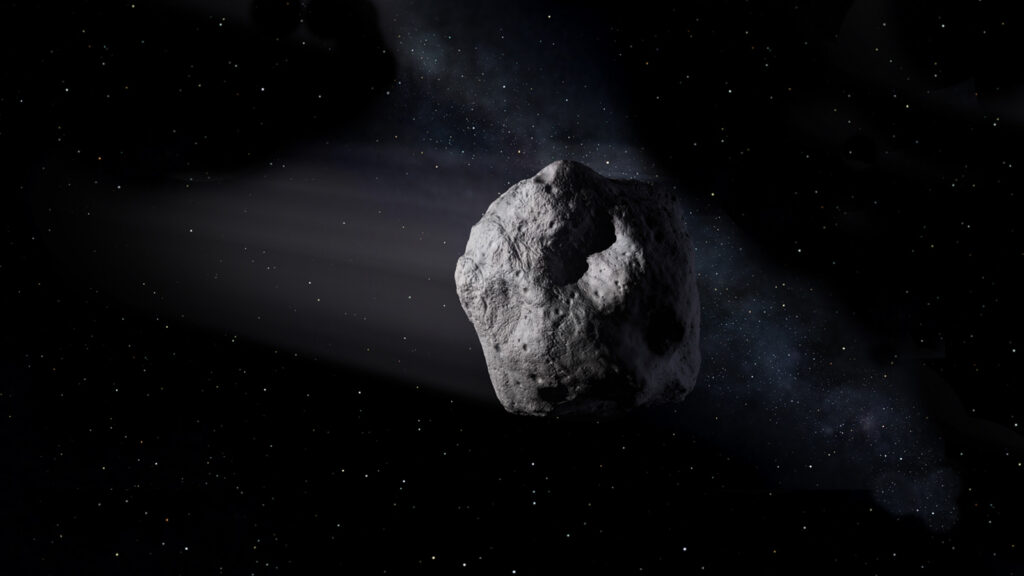
Commentary
Numerous media outlets have reported on the asteroid 2011 ES4. A simple internet search for 2011 ES4 will result in many stories and videos. So one may ask a question: “Is there any danger from the asteroid 2011 ES4?” Not for the year 2020. However, there is a very tiny risk for the years 2031 to 2112. This risk is far below the “background hazard” and is from uncertainty in the known orbit. If 2011 ES4 is recovered in 2020 more likely than not it will be removed from the risk lists. While it is known that 2011 ES4 will not impact the Earth in 2020, there are eight days and eight minutes of uncertainty in the close-approach time. Many times some press outlets will ignore the uncertainty and only give the maximum size and minimum distance; leading to confusion as new data comes. For more information check the links below.
That's based on the nominal orbit in JPL HORIZONS. The uncertainty band stretches for several million km. Here's a calculation of the uncertainty region passing the Earth and Moon from 25 Aug to 6 Sep pic.twitter.com/XKSypQoCkj
— Peter Thomas (@ptastro1) June 7, 2020
Background(as of 2020-08-22)
- Object: 2011 ES4
- Orbit Type: NEO (Apollo)
- Approximate Diameter: 22 m – 49 m [72.18 ft to 160.76 ft] (Absolute H= 25.4)
- On the Sentry Risk Table: YES [75 Number of Potential Impacts 2031-2112 ]
- Torino Scale (maximum): 0
- Palermo Scale (maximum): -5.12
- Palermo Scale (cumulative): -4.66
- for more information on risk, pages read Understanding Risk Pages by Jon Giorgini
- On the NEODyS CLOMON2 risk page: YES[ 128 Number of Potential Impacts 2031-2115]
- Torino Scale (maximum): 0
- Palermo Scale (maximum): -5.16
- Palermo Scale (cumulative): -4.68
- Listed on the Goldstone Asteroid Radar Schedule: No
- Listed on the Arecibo Asteroid Radar Schedule: No
- Radar Observations: none
- Discovery observation was made: 2011 03 02.19847 (04:45:47.81)
by Mt. Lemmon Survey (MPC Code G96) - Last Observation(publish) was made: 2011 03 06.23495(05:38:19.68) by LPL/Spacewatch II (MPC Code 291)
- The number of Optical Observations(published): 45
- Oppositions: 1
- Observation arc: 4 days
- The number of Observatories Reporting (Published) Observations: 6
- Observatories Reporting (Published) Observations(MPC Code):
- (291) LPL/Spacewatch II, Arizona, US
- (586) Pic du Midi, France
- (G96) Mt. Lemmon Survey, Arizona, US
- (H01) Magdalena Ridge Observatory, Socorro, New Mexico, US
- (H21) Astronomical Research Observatory, Westfield, Illinois, US
- (J95) Great Shefford, UK
- Perihelion Distance: 0.826 AU
- Aphelion Distance: 1.354 AU
- Earth MOID: 0.000665648 AU ( 0.259 Lunar Distance) 15.613 Earth radii
- Close-Approach to Earth:
- Date and Time(TDB): 2020-Sep-01 16:12
- Time Uncertainty: 8 days 00:08(11528.4038364212 minutes)
- Minimum Distance: 0.000477632840390022 (AU), 0.186 (LD) 11.203 Earth radii
- Nominal Distance(best fit): 0.00081083276352288 (AU), 0.316(LD), 19.018 Earth radii
- Maximum Distance: 0.105985053543994 (AU) 41.246 (LD), 2485.857 Earth radii
- Will, it Be Visible to the Unaided Eye: No
Sources
- Asteroid (NEO) 2011 ES4 Information (TheSkyLive.com)
- ESA 2011 ES4
- 2011 ES4 -- Earth Impact Risk Summary
- JPL Small-Body Database Browser (2011 ES4)
- MPC Database Search — 2011 ES4
- Palermo Technical Impact Hazard Scale
- Introduction to Sentry: Earth Impact Monitoring
- Sentry: Earth Impact Monitoring
- Torino Scale
Other Useful Links
- Asteroid Hazards: The View from Space(MPC)
- Don’t fear apocalyptic asteroids: you’re safer than you think
- Frequently Asked Questions For Impact Risk Assessment
- NEO Search & Follow-Up
- Palermo Technical Impact Hazard Scale
- Quantifying the risk posed by potential Earth impacts Steven R. Chesley (JPL), Paul W. Chodas (JPL), Andrea Milani (Univ. Pisa), Giovanni B. Valsecchi Icarus 159, 423-432 (2002) ( PDF )
The Asteroid 2020 NK1 Has Been Removed From Sentry: Earth Impact Monitoring